
Pro-Irishness was part of the Democratic-Party-dominated political culture that MAGA despises and whose day is done. Time for Ireland to opt once and for all for Brussels over Boston, argues the co-editor of the Dublin Review of Books.
The myth of European exceptionalism no longer holds: the continent’s boundaries are arbitrary, its heritage mixed and controversial, and unfit for a unified identity to hold it together. If we give up the commonplaces that have proven insufficient, what can then define and unify this peninsula of peninsulas? True democratic dissent, Ferenc Laczó argues.
Since the dawn of modernity some five centuries ago, the citizens of all sorts of European states have tended to perceive their continent as a highly specific and an especially valuable place. Europeans today increasingly – and rightly – view their continent as a rather small corner of the world that may no longer be of central import in global affairs. However, many Europeans also believe the European political and social model – transnational governance of liberal democratic nation states embedded in capitalism, also known as the social market economy – to be of universal validity and relevance.
Although Europe has clearly declined in relative terms and is no longer enjoying a large share of global power and influence, many Europeans at least implicitly hold on to the idea that Europe is a particularly civilized place that other continents could emulate to their own benefit. Basic global realities and the actual relationship between the continents may have drastically changed during the lifetime of recent generations but our conceptualization of Europe’s place and role in the world reveal remarkable continuities.
This begs a large question: how do we think about Europe today and why? I would like to discuss this question with a focus on some select aspects I consider particularly relevant. After all, few concepts may seem so important to us today as the concept of Europe does, yet over time its semantics has changed significantly. The idea of Europe has crossed many boundaries, transitioning from mythology to geography, and on to religion and culture, to then become a contested political concept in our age. The name of a princess from Greek mythology came to be used as a geographic expression to refer to a newly invented unit – and not even the part of the world where she was from. This part had acquired a religious and cultural-civilizational connotation to then, in the last roughly hundred years, be launched as a political project with an uncertain outcome.
Although the origins of Europe are popularly traced back to ancient times, specifically ancient Greece and Rome, as a political project Europe is in fact a recent and quintessentially modern invention. Europe certainly makes claims to be a place of intellectual innovation and open, democratic argument. I’m afraid, however, that most of its citizens have difficulties figuring out which thinkers truly matter when it comes to the subject of Europe, and what would be the right forum to debate their ideas in an impactful way.
Paraphrasing Benedict Anderson, the great theorist of nationalism, we could say that these problems amount to three European paradoxes. These paradoxes lie between Europe’s proud exceptionalism and simultaneous claims to universalism; the centrality of Europe’s historical consciousness and the pursuit of a new kind of project aimed at ‘overcoming its conflictual and traumatic history,’ and the attempt to develop a democratic polity without having an agora.
Whereas the geographic borders of Europe are rather clear in the West, the South and the North as they are defined by major bodies of water, Europe has no clear boundaries in the East. After all, Europe is just a part of the much larger Eurasian landmass. Usually placed somewhere in the middle of Russia and Turkey, the supposed border between Europe and Asia is, of course, highly artificial – irrespective of whether it is supposed to refer to rivers, mountain ranges, or even the middle of the continent’s most populous metropolis, Istanbul.
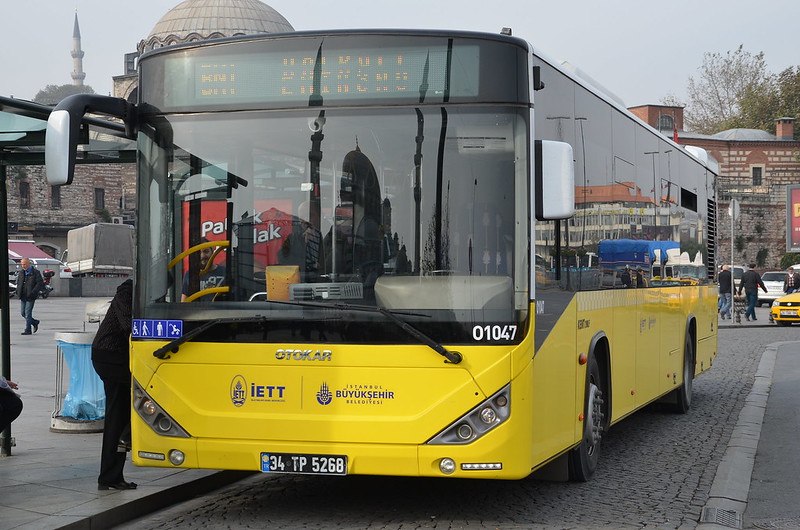
Kadiköy – Eminönü: this city bus leaving from Eminonou Square in Istanbul crosses the border between Europe and Asia about seven times a day. Photo by shankar s. from Flickr
Let us pause just for a second to consider what we would think of Russian geographers, were they to declare a continental divide in the middle of Germany because of some river or mountain there. Or of Turkish cartographers inserting a continental border across France’s biggest city? I sincerely doubt we would take such a proposition seriously or expect it to acquire great influence over popular perception. And yet, this is precisely what has happened in the case of the purported border between Europe and Asia.
Europe is thus a continent of our imagination rather than an actual geographical unit, one apparently in constant need of inventing its own limits vis-à-vis the East to remain distinct, while often also pushing eastward to spread the European idea further. Where Europe ends and Asia begins has thus been a question primarily about historical formations, civilizational differences, and matters of identity; it is a question about symbols which profoundly shape our reality.
It is important to realize that the Europe-Asia divide has rarely been conceived in a symmetrical or neutral fashion. When invented and increasingly enforced as the standard way to view the world, this imaginary border was not only about a divide in space but also about a gap in time – about the synchronicity of the asynchronous. As their continental consciousness grew, the people of Europe tended to think of themselves as more advanced than their Asian counterparts.
Asia as an adjacent continent was supposed to be stuck in the recent past of Europe, and some of its parts were meant to be immobile, essentially stuck in their own ancient past. We may even go as far as to suggest that Europeans invented not only the idea of Europe, but also that of Asia, and did so to show what Europeans had and others did not; Asia has been defined not in a positive sense but rather in how it differed from Europe and what it lacked to be like it. This is a very curious way of looking at the world, not least because, according to the same scheme, most humans are categorized as ‘Asian’ today.
Of course, few of us would conceive of Asia today, particularly what we call the Far East as less dynamic than Europe, or as lagging behind Europe in its evolution. If Europe no longer stands for being progressive and for being exceptionally developed, it arguably needs to assert that it has a specific model of modernity to remain distinct from Asia. And that is precisely the process we have observed in recent decades. The historical justifications for Europe’s advanced status are inherited from earlier epochs are being undermined for good reasons. And yet, all the more normative-sounding arguments are being reasserted for Europe being a model of global relevance, not least by representatives of the European Union.
There is an intra-European layer to the same question that I would like to address as well. If Europe has been defined by continuously distinguishing itself from ‘the East,’ where does that leave eastern Europe, that part of the world which combines these two concepts in its very name?
The place and role of eastern Europe appears crucially important. Often understood as a part of Europe that is not quite fully European, as a sort of demi-Orient within the geography Europe, eastern Europe was precisely the part of the world against which the so-called European project first defined itself against after 1945. This implied a strange asymmetry that has certainly not disappeared since the east European transformations starting in 1989-1991. I would go as far as to suggest that the western European perception of eastern Europe still contains elements of the Orientalist manner of thinking. The attitude behind it is rather comparable to those that historically characterized those toward Asians.
The two relationships differ in one crucial respect, however, and that is because eastern Europeans, unlike Asian people, have repeatedly made vocal claims to belonging to the same category of Europeans. As eastern Europeans embarked on the path of Europeanization after 1989, they had wished to be seen as Europeans just like their western counterparts, and to be accepted as such, with all their evident similarities and notable differences. Western Europeans nevertheless tended to assert their right to measure and assess the Europeanness of eastern Europeans. By measuring them against their own criteria, westerners would either find that certain countries of the ‘other Europe’ were worthy enough to belong to the European project, or that they fell short of that and should not be included.
These relationships have lasting implications on the present, one of which is that eastern Europeans have been asserting their right to belong to Europe in recent decades and have increasingly also insisted on their right to exclude others. This has been a highly controversial process that is much debated today. It appears fairly evident that some of the most eager Europeanizers of recent decades, such as Poland or Hungary, ended up electing government with exclusivist perspectives on Europe and Europeanness. Instead of internalizing the liberal-normative project of the West, these governments have started to propagate civilizational, religiously connoted and at times even explicitly racist ideas of what Europe ought to stand for.
At first sight, the fact that some of those who recently entered a transnational union of liberal democracies are turning illiberal and nationalistic amounts to a contradiction. The process sounds paradoxical, but not necessarily illogical. After all, for these ‘demi-Orientalized’ countries in eastern Europe, Europeanization was, in Attila Melegh’s phrase, also about moving further up on what he aptly calls the East-West slope, and thereby also about creating greater distance between themselves and countries further to the East. As Melegh pointedly argues, ‘Europeanizing yourself’ and Orientalizing others might indeed be two sides of the same coin when it comes to post-communist eastern Europe.
Where does all that leave us when it comes to the geographic notion of Europe? Are we to understand that our continent is little more than a figment of our imagination and a quite arbitrary figment at that? Quite the opposite, I would say. I would even insist that European history and Europe’s place in modern history can only be properly understood through a solid grasp of this imaginary continent’s geographic features.
If Europe is not a properly distinct continent, what is it then? Seen in the larger context of the Eurasian landmass, Europe is indeed just a peninsula. It also consists of numerous further peninsulas. And being such a peninsula of peninsulas has two consequences of huge import.
One is that Europe has extremely long coastlines relative to its area. The most remote place from any sea or ocean, the point of inaccessibility as sea travellers tend to call it, is slightly more than 2 500 kms away from the closest coasts in Eurasia. The same figure would be a fraction of this for Europe; moreover, geographers will not even designate such a point of inaccessibility since they rightly do not consider Europe a separate landmass. The sea is relatively close to practically every point of our peninsula of peninsulas, not to mention that the vast majority of our countries have direct access to the sea.
We may therefore say that countries in Europe look outward as much as inward. That is indeed a major geographic reason why European history has been so deeply embedded in and able to shape global history over the past five hundred years, especially when the sea had to be fared and could not yet be flown over.
Being a peninsula of peninsulas has another major consequence. The continent appears to have a geographic centre of sorts in the relatively few countries that have no access to the sea, such as Switzerland, Austria, the Czech Republic, Slovakia, Hungary, or Serbia. Yet, these are not gravitational centres towards which the rest converges and from where it would be relatively easy to control more peripheral areas. The fact that no single power has ever managed to rule over all of Europe is clearly related to this peculiar geographic feature.
Contrary to the EU’s favoured rhetoric about creating unity, the pattern of no single power ruling all of Europe has very much continued after 1945 as well. It still holds true today, if with a curious twist. For the latter, we only need to recall the sheer fact that the two largest countries in Europe, Russia and Ukraine, are not part of the European Union to date, nor are they likely to enter the Union in the foreseeable future; its population barely shy of Germany’s, Turkey currently functions as a buffer zone for the EU to slow down the influx of refugees from the Middle East and Central Asia.
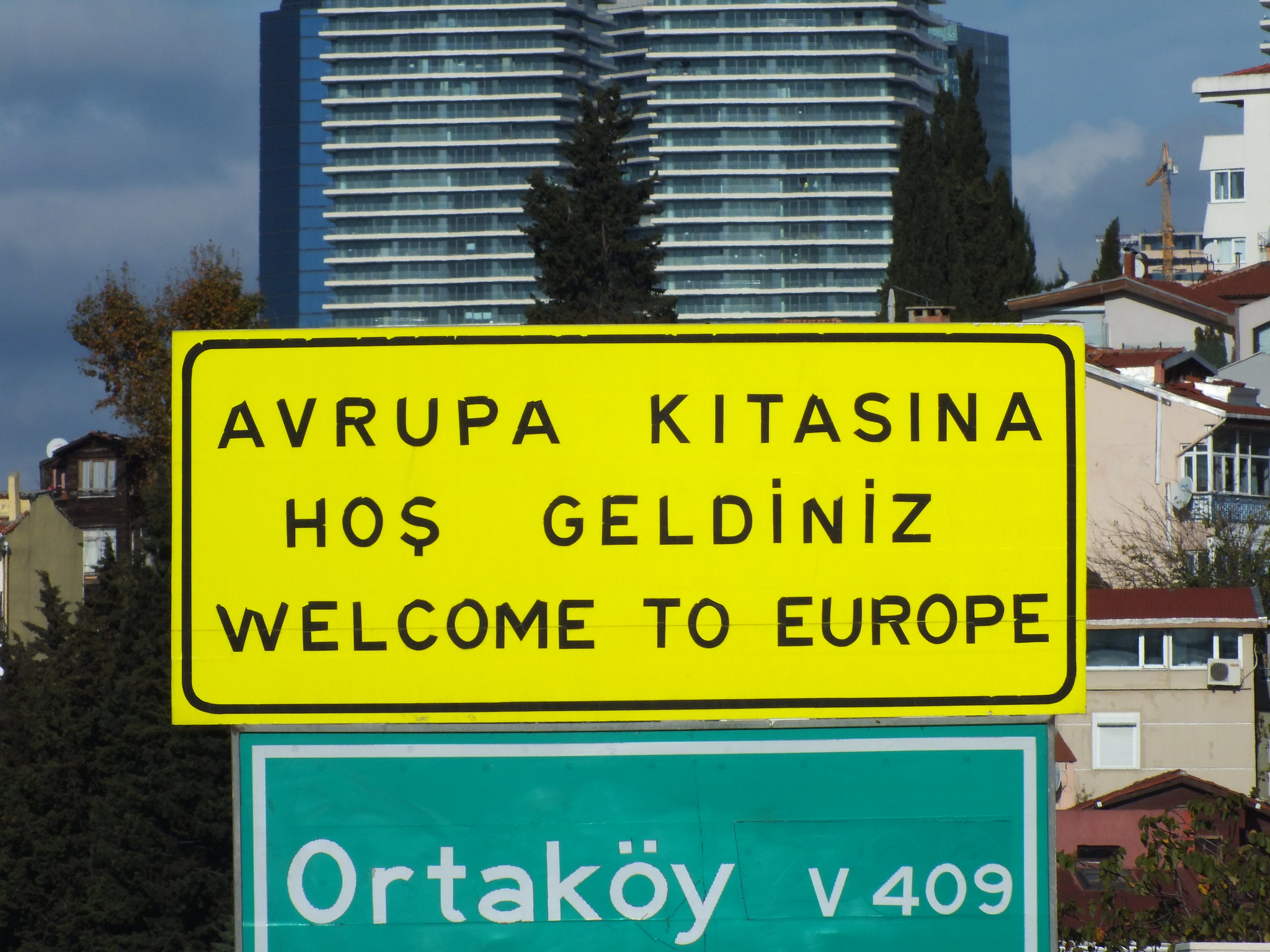
Welcome to Eurasia. Photo by Pi István Tóth from Flickr.
Observed from this angle, the EU and its predecessors have been little more than a continuation of a centuries-old trend in European history of great powers cooperating with each other to make sure no single one of them becomes too dominant over the rest. This very much applied to the European communities after 1945, established largely to oppose the Soviet Union during the Cold War.
What is rather unusual about the situation today is that Russia – the major successor state to the Soviet Union, which has itself long been understood as a European great power and has indeed played a central role in the frustration of both major military attempts to dominate Europe in modern times, those of Napoleon and Hitler – tends to no longer be viewed as European. At the same time, Russia is still perceived as a major competitor, just like during the Cold War, even as it is no longer the single most powerful contender for power in Europe.
The European great powers and smaller nation states are now uniting with each other and against another great power which is far from having a chance to dominate them – and not even quite accepted as European any longer. This anomaly certainly does not leave Russia with many opportunities to play a constructive role in European affairs, even if it tried.
Some people insist on the Christian foundations of the European project, or even the desirability of a Christian character. However, it is not so much in these moderately successful attempts that we see the real religious connotations of Europe. The manner of religious othering is where a secularized Christian perspective may be detected, and its consequences observed.
There are two critical relations here: between Europe and Judaism, on the one hand, and between Europe and Islam, on the other. Both have been a source of much controversy across the centuries and in recent decades which I cannot hope to tackle beyond trying to offer a few insights.
It is worth addressing these relations together to observe a curious reversal. It is something of a cliché to state that European identities were shaped through the long-standing relationship and contest with Islam, a major force directly impacting European history, often depicted as an external and threatening ‘other.’
In the case of Judaism in Europe, almost the exact opposite was the case prior to WW2 and the Holocaust. Jews tended to be viewed by members of the so-called majority society of Christians as an ‘internal other’ and were depicted by anti-Jewish forces as a group whose influence was morally dubious and even illegitimate. While its impact could be acknowledged in many ways and Islam still not be accepted as ‘truly European,’ in the case of Judaism it was precisely the opposite: Jews have clearly been a part of European societies whose impact, however, has been repeatedly and malevolently questioned and deemed harmful.
It was on the basis of such moralizing critiques that Jews had been repeatedly persecuted nearly all across the continent throughout Christian history, and ultimately during WW2. It was a vicious and horrific reaction to Jewish assimilation and Jews’ growing visibility and impact on society that the unprecedented atrocity of the genocide against European Jewry was committed.
Since the end of WW2 and the start of de-colonization, this contrast between Islam and Judaism has become much blurrier. A key novelty is, of course, that a large majority of Jews now live outside Europe, whereas the presence of Muslims in many European societies has significantly increased.
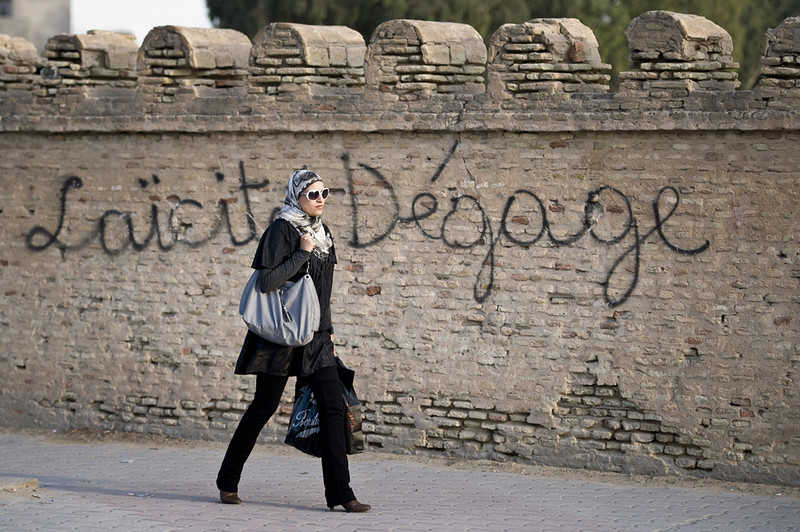
A Tunisian woman passing by an anti-secularist graffiti. Photo by EU Election Observation Mission in Tunisia, European Parliament via Flickr.
In this new, post-Holocaust context, the Jewish contribution to the history of European civilization can be acknowledged in a positive sense but at a time when Jews are increasingly seen as a people basically from outside Europe, holding only limited visibility and impact within the continent. As for Islam, the presence of Muslims as members of European society is an obvious fact nowadays, even if Muslims often remain marginalized citizens. At the same time, the perception of an Islamic threat has certainly not vanished, and have in fact radicalized in recent decades.
Many Europeans today appear to combine two traditions of relating to Islam which developed in clear historical succession. The fear of a powerful and advancing Islam originally developed before the 15th and 16th centuries, and is nowadays often combined with a sense of superiority that characterized more recent centuries of European imperialism and colonialism. This is a striking ambiguity. It is equally striking how often the presence of Islam and the roles of Muslims are discussed and debated in Europe; our largely secular societies at times appear nearly obsessed with religious difference.
In modern times, religion is supposed to be one layer of social reality with a logic of its own. It is supposed to exert some mutual influence on but also be largely independent of other subsystems such as politics, economy, even culture. As many have remarked before me, this specific and specifically modern idea of religion was intimately connected to the development of Protestantism.
It had required serious reconsideration, reform, and a sort of downscaling of Judaism from the late 18th century onward to try and make it conform to such a modern concept of religion, to create, a Jewish religion out of Judaism. Whether Judaism is a mere religion in the state of Israel today, i.e., a largely independent subsystem, is far from evident, of course.
Islam throughout the 19th century was frequently described with the concept of civilization, rather than the post-Christian sense of religion. Returning to and reconsidering this alternative categorization today can be quite illuminating as we need to reflect on civilizational differences when considering the formation of the modern and the secular.
Many issues debated regarding Islam as a religion and how it makes claims beyond what we consider the strictly religious realm may derive from two simple but consequential facts: our rather narrow conceptualization of what religions are and do, and our subsequent and ambiguous categorization of Islam as a religion. Islam may be a modern religion but also not quite a religion like Christianity in a secular context. Islam’s own brand of secularism needs to be derived from within its own civilizational matrix, and such secularism may take a somewhat different shape from the Christian version.
After all, European and, more broadly, Western civilization as a secular project is not so much defined by Christianity but by a secular tradition that has emerged in a critical dialogue with and as a counterpart to the Christian religion.
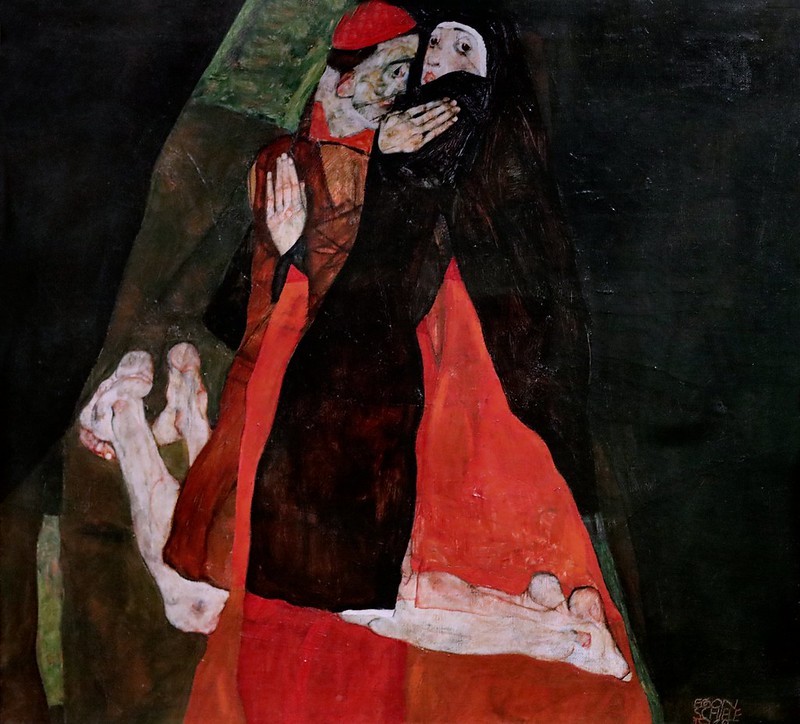
Egon Schiele’s Cardinal and nun (Caress) 1912 at Wien Leopold Museum Photo by jean louis mazieres from Flickr.
The rather fraught relationship between ‘Europe’ and ‘Islam’ could be significantly improved if the origins of the category of religion were better understood, and perhaps reconsidered in an inter-civilizational exercise.
European identity has certainly become something of a buzzword in recent decades. European institutions have started adding cultural issues to their agenda starting in the 1970s and 1980s. Fostering a stronger European identity has emerged as an additional pillar of the European project, a largely economic, legal, and bureaucratic project with limited emotional appeal.
The economic and increasingly political project of European integration has produced a highly differentiated space which simply cannot be grasped adequately through the concept of identity. Some countries are in the Eurozone, some others in Schengen, some are in neither but still members of the EU. Others might use the Euro as their currency, such as Montenegrins, or apply Schengen rules without being EU members, as do the Swiss. And then there are other countries where none of this applies but where the local pro-democratic citizenry is ready to fight on the barricades under the European flag, as we have seen in Ukraine or we can currently observe, if to a lesser degree, in Belarus. It is simply impossible to grasp such diversity through the notion of European identity.
This overreliance on a static concept like identity, similarly to the frequent use of the odd label ‘Eurosceptic’, rather point to an underdeveloped political culture. After all, democracies are defined not by what citizens share in terms of their identity choices, but rather by how substantially their citizens manage to debate key issues and reach mutually beneficial compromises without necessarily arriving at full consensus. However, the European Union today is a curious project of liberal democracies that struggles to construct its own lively and impactful agora.
As Luuk van Middelaar has recently proposed, it would be time for the EU to overcome the crippling preference for consensus and bring in the opposition. I very much agree with this proposal. After all, the EU still lacks a real democratic opposition that would propose alternative agendas with the intention of acquiring power to try and implement them. At the same time, the EU has recently – and I should add, rather belatedly – started to confront a Fundamentalopposition primarily in the shape of the Polish and Hungarian governments that appear unwilling to respect basic European norms and values.
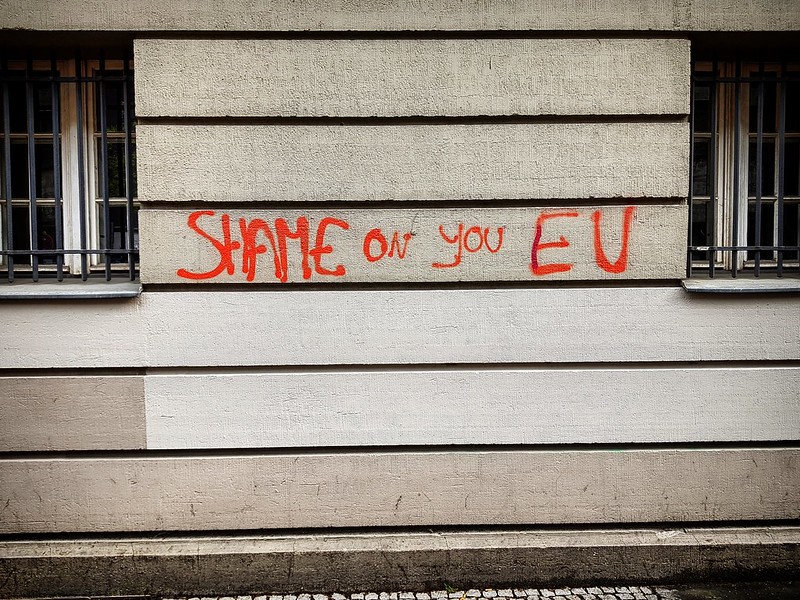
Graffiti in Neukölln denouncing the EU over immigration controls and anti-refugee policies. Photo by Hossam el-Hamalawy from Flickr.
I also think that before an opposition within a more fully democratic EU can arise, we need to develop further our European culture of respecting and appreciating dissent. I find the current situation to be rather dissatisfying in this regard. The challenge posed by the Hungarian and Polish governments might soon result in a full-blown institutional crisis of the EU. This has much to do with the fact that a key difference has long been overlooked between legitimate dissent and a Fundamentalopposition to liberal democratic standards, which should be considered illegitimate.
We would be well advised to stop valorizing European identity and start encouraging dissent on the European stage. Coalescing into a broad transnational movement of democratic opposition, dissenting Europeans could soon replace the Fundamentalopposition to the liberal democratic order we see today.
European integration has transformed into a new kind of project after 1945, but it also pursued a much older ambition: to assure that no one major power should ever dominate the continent. A specific form of historical consciousness was central to this European project: the remembrance of a traumatic recent past. This new kind of project aimed at ‘overcoming history’ by making reconciliation appear necessary. However, the internal-European borders of the Cold War divide clearly defined where the European project ended until 1989-90. Expansion and exclusion have been the two sides of the same coin ever since. Similarly, Europeanizing oneself and Orientializing the ‘other’ appear to have gone hand in hand in the newer member states of the EU.
During the Cold War and ever since, the purportedly post-historical space of the European project has in fact continued to be surrounded by the ‘terror of history’ across its borders, whether in former Yugoslavia in the 1990s or in Syria or Libya currently. The European project has managed to externalize rather than truly overcome traumatic history – and its own post-traumatic historical consciousness has been of great help in achieving this much.
The concept of identity cannot properly grasp the highly diverse space that European integration has created in the recent decades. Europe will have to learn to view itself as just one corner of the world and improve its democratic politics to meet this reality. We would be well advised to try and develop more powerful ways to contrast European practices with European values and view political dissent as the urgently needed starting point for developing an agora worthy of a democratic union.
This article is based on a lecture presented at the YUFE Academy.
Published 10 September 2021
Original in English
First published by Eurozine
© Ferenc Laczó / Eurozine
PDF/PRINTSubscribe to know what’s worth thinking about.

Pro-Irishness was part of the Democratic-Party-dominated political culture that MAGA despises and whose day is done. Time for Ireland to opt once and for all for Brussels over Boston, argues the co-editor of the Dublin Review of Books.
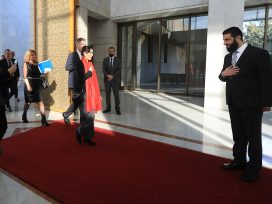
Syria’s reinvigorated civil society must assert itself not just in negotiations with the new government, but also in its dealings with Europe. Neo-colonial assumptions regarding minorities and gender are a source of tension that Europe would do well to reflect on.